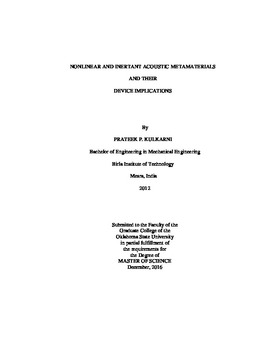| dc.contributor.advisor | Manimala, James M. | |
| dc.contributor.author | Kulkarni, Prateek Purushottam | |
| dc.date.accessioned | 2018-06-29T14:41:02Z | |
| dc.date.available | 2018-06-29T14:41:02Z | |
| dc.date.issued | 2016-12-01 | |
| dc.identifier.uri | https://hdl.handle.net/11244/300356 | |
| dc.description.abstract | Acoustic Metamaterials (AM) are a class of artificial structural materials that derive their unique dynamic properties, not just from material constituents but more so from engineered local configurations. Tailoring these local configurations have been shown to impart unusual mechanical wave manipulation capabilities to AM with potentially novel applications in protective structures; acoustic devices for sensing, noise control, and energy harvesting; and MEMS devices. Most AM require the presence of periodic features that locally exhibit dynamic phenomena like resonance or instability within a host material or structure. A key advantage of the AM design approach is the latitude to explore new local configurations to further enrich their dynamic behavior. The present study focusses on nonlinear and inertant AM configurations and their device implications. Using the method of multiple scales applied to a lumped-parameter effective-mass model, approximate analytical solutions were derived for the amplitude-dependent dispersion curve shifts in nonlinear AM owing to the presence of cubically hardening or softening nonlinearities in local oscillators. Discrete element simulations predict the possibility of realizing passive acoustic control devices such as selective filters, amplitude band-pass filters and direction-biased waveguides using nonlinear AM. A numerical routine to generate root profile geometries that enable contact-based hardening response in tip-loaded cantilever beam resonators was developed and implemented. Experiments on a structural waveguide test article verify the existence and extent of bandgaps and also provide an indication of the passive direction-bias phenomenon. Whereas, incorporating inerters, which are mechanical elements that display a force proportional to the relative acceleration across them, could create structural devices that display frequency-dependent negative and even extreme effective-mass and stiffness regimes. Such devices have implications for passive high-pass filters with ultra-low frequency bandgaps that encompass the long wavelength limit and can be realized without the use of any mechanical grounding elements and even for structural networks that can act as a nearly complete mechanical wave inhibitor. Further research on the interactive synergies between nonlinear and inertant configurations and practical strategies to scale and fabricate them could have promise for realizing a new class of AM with enriched dynamics beyond those found in predominantly locally resonant variants that are currently being developed. | |
| dc.format | application/pdf | |
| dc.language | en_US | |
| dc.rights | Copyright is held by the author who has granted the Oklahoma State University Library the non-exclusive right to share this material in its institutional repository. Contact Digital Library Services at lib-dls@okstate.edu or 405-744-9161 for the permission policy on the use, reproduction or distribution of this material. | |
| dc.title | Nonlinear and Inertant Acoustic Metamaterials and Their Device Implications | |
| dc.contributor.committeeMember | Good, James K. | |
| dc.contributor.committeeMember | Jin, Xiaoliang | |
| osu.filename | Kulkarni_okstate_0664M_14938.pdf | |
| osu.accesstype | Open Access | |
| dc.description.department | Mechanical & Aerospace Engineering | |
| dc.type.genre | Thesis | |
| dc.type.material | text | |
